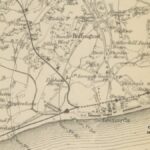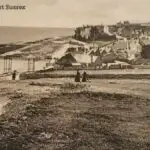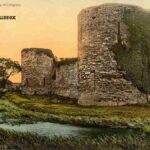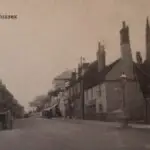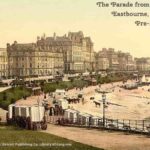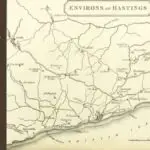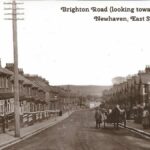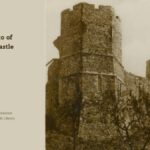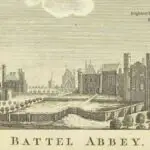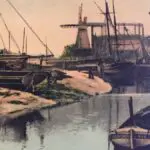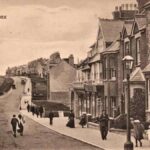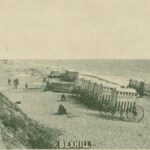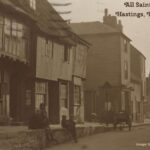Glimpse history through old images of Wannock, East Sussex, England.
Road Safety Signs 1938
Notice Boards Issue Title Is Spring In The Air (1938) – British Pathé on YouTube
Tropical Gardens in the 60s
Tropical Gardens Aka Tropical Flowers Beware – Other Colour Pics Share This Title (1960) – British Pathé on YouTube
Out Takes / Cuts From Cp 299 – Tropical Gardens Aka Tropical Flowers (1960)– British Pathé on YouTube
Tropical Gardens Beware – Other Colour Pics Share This Title (1963) – British Pathé on YouTube
A Bit of Wannock History
Extract from: Powell’s popular Eastbourne Guide, Lodging-House Keepers’ Directory, etc, by James Henry Powell
Published in 1863
Pages 30 – 31
We have elsewhere expressed a favourable opinion of Wannock , but
should ill perform our duty did we omit to notice a few of its principal
characteristics . Those who fear to venture three or four miles out on
foot can choose a conveyance either by road or rail , and reach Wan
nock with ease . The distance from Polegate station to Wannock is one
mile . For ourselves we rather choose , in company with a con
genial friend , to walk . Directing our feet to Willingdon , over the
fields near the Railway station , we soon leave Eastbourne behind us ,
and obtain glimpses of scenery diversified and pleasing . A walk of
two miles brings us to Willingdon , a pretty village , which of itself pre
sents few features – other than its sequestered site and surrounding
walks calling for special description , but it forms a resting place between
Eastbourne and Wannock , and may be noticed in passing .
Wannock has long been famed for its strawberry gardens , but ap
pears to have been overlooked for its delightful scenery . We speak for
ourselves when we assert that , outside Eastbourne , no spot of equal
size can be found of its character , where Nature has had her will , more
beautiful in the range of Sussex . A complete transformation of scene
is visible the moment the eye obtains a full view of Wannock and its
adjoining hamlet Filching .
The last occasion we found ourselves at Wannock , we stood in front
of a garden , admiringly gazing at a glorious harvest of goosberries ,
which weighed down the trees so much as to make it necessary for their
owner to support them with props . We accosted their proprietor ,
Mr. Thomas , a rustic veteran of upwards of eighty summers , and speed
ily effected a purchase with him of some goosberries . The old man
seemed ” as happy as a king , ” while his frame treml’ed beneath the
weight of years , like an aspen leaf . We entered his cottage and found
in his humble abode objects old – fashioned , but suggestive of Life and
Nature . His wife , almost as aged as himself , presented us with a
” wee drap ” from an antiquated bottle which bore date 1742 – a curiosity
for our modern Pallissers . The strawberry gardens , belonging to the
son of our good host , next attracted our feet , but we experienced a
regret here when we discovered the significant fact that we were a little
too early for a dish of cream and strawberries , a delicacy we plead a
penchant for . To describe the prolific sources of these gardens would
take more space than we can afford . We therefore pass on to ” Lovers ‘
walk , ” which we reach by a gate to the right , and immediately gain
a view of a second Paradise . This walk forms a margin to a woody
glen , and certainly possesses attractions differing from any scene in
Eastbourne . A rapid current of clear water used for working the ” old
mill , ” gurgled in tune to the chorus of birds giving our spirits joy .
The lithe willow spreading its graceful branches across the stream , the
birch and beech trees , and the populous fern leaves , interspersing a
forest of meek – eyed wild flowers , and the Filehing hill with its high sum
mit kissed by the setting sun , combined to form a most enchanting
palisade .
At the end of Lovers ‘ Walk we come to an old building , said to have
been built in the time of Queen Elizabeth , once the abode of some
high folk , ” but now turned into three cottages , and inhabited by
three peasant families . The old – fashioned wooden doors , emblematised
with huge nails , and the American fuchia , like clusters of ivy , trailing
itself over the top and down the sides of this curious building which ,
reposing in its pristine pride at the foot of the downs , sheltered on one
side by a luxuriant wood , and open on the other side to the wide wheat
fields and groves beyond , present a picture to think about .
..
Speaking to a woman , occupying one part of the building , we gleaned
he intelligence that each family was tenanted for one shilling per week ,
not a heavy rent to be sure ; but the sequel- ” We be ten in family and
nine of us have to live on eleven shillings per week . ” What ! in this
Christian England ? In the boasted age of civilization . Yes , reader ,
this peasant wife’s tale is true of thousands . Let Dives button his pockets
and look to his banking books . Lazarus , weak and sore , must needs
go tottering from the rich man’s door to the workhouse and the grave .
Yet the Almighty made us all .
More about East Sussex
- Old Images of Wannock, East Sussex
- Old Images of St Leonards-on-Sea, East Sussex
- Old Images of Crowhurst, East Sussex
- Old Images of Rottingdean, East Sussex
- Old Images of Pevensey, East Sussex
- Old Images of Hailsham, East Sussex
- Old Images of East Sussex, England
- Old Images of Winchelsea, East Sussex
- Old Images of Newhaven, East Sussex
- Old Images of Lewes, East Sussex
- Old Images of Crowborough, East Sussex
- Old Images of Battle, East Sussex
- Old Images of the Pestalozzi Children’s Village, Sedlescomb
- Old Images of Rye, East Sussex
- Old Images of Seaford, East Sussex
- Old Images of Sidley Green, East Sussex
- Old Images of Bexhill-on-Sea, East Sussex
- Old Images of Hastings, East Sussex
- Old Images of Eastbourne, East Sussex



